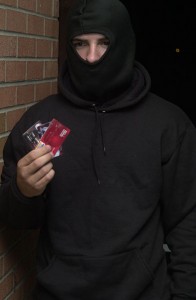Today we want to pass on some wisdom that many banks and credit card agencies offer. It’s easy to take the power of a credit card for granted. You swipe it, the bill is paid, you move on. It’s a system designed for convenience. The problem with it is that this power is identical if your card is wielded in your hand or in someone else’s. Something is purchased and you get the bill. But if someone else swiped the card, all you get is the consolation prize of receiving the bill. To keep your financial information safe, there are a few easy steps that you can take.
- If your credit card provider offers the option of adding your photograph to the card, take it. It will be very hard for a thief to use this card in person.
- Only give your card number out over the phone if you initiated the call. This goes for all your personal information. Your bank already has you card number. They don’t need you to repeat it when they call you.
- Never write down your PIN or CVV. Anywhere. They are small numbers and need to be remembered.
- Save your receipts, at least until after the credit card bill comes in. And always check to make sure that you were charged the amount you had agreed to pay.
- Carry only the cards you need. You may need one or two or maybe even three. Odds are that you will not need all 18 of your cards when you go grocery shopping.
- Some security consultants advocate not signing the back of the card, but writing “see ID” in the signature line. Have your driver’s license ready to match the picture to the name. It forces a secondary verification that the card is really yours.
- Don’t lend your credit cards to anyone any more than you would give them your driver’s license or social security card. This is information personal only to you. Legally it can not be used by anyone other than you.
- Have a list of your cards with their account numbers and issuing bank phone numbers in a safe place. If your card is lost or stolen, call to report it right away!
- When shopping on-line, always look for the green lock on the browser address bar before entering your personal information. The closed green lock (which you can click on) verifies that the site is legitimate and is secured using SSL 3.0 encryption. If you see an open red lock, RUN!
- When using an ATM, use your other hand to cover the hand entering your PIN. It’s a short number and it can cause a lot of grief if it falls into the wrong hands.
- If you’re trying to decide between a credit card and a debit card, please remember that in fraudulent transactions your liability limit with a credit card will not exceed $50. With a debit card that liability limit is the size of your bank account.
- It’s a good idea not to let your credit card out of your site during a transaction. It’s very easy to duplicate the track data from the magnetic strip on the back – it just takes one swipe!
Smart security practices will help you avoid identity theft issues. It’s still up to the merchants you deal with to keep your information secure on their end. As Target recently demonstrated, even those who we think we can trust sometimes fail. Nothing will ever be 100% safe, but good practices on your side can help make your financial information a lot safer.
[whohit]2014-01-22 Credit Cards 3 – Things You Should Do[/whohit]


Pingback: Credit Cards, part 2 - PayPal’s Security | a Snaggy diMe Blog